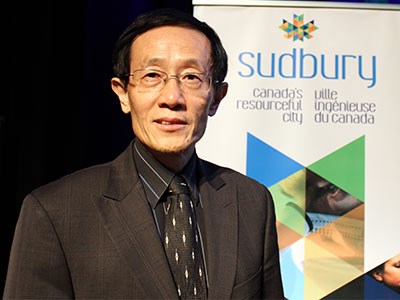Sudbury’s environmental destruction and subsequent reclamation is one of the city’s defining moments. From a blackened, barren nickel capital to a beacon of regreening and responsible mining around the world, Sudbury has come a long way since the 1970s.
A major project is germinating between the mayor’s office and Laurentian University that would capitalize on the expertise built from the recovery process.
Laurentian’s vice-president of research, Rui Wang, introduced the Sudbury Protocol at the Greater Sudbury Development Corporation’s (GSDC) first Resourceful City talk in November.
Wang describes the protocol as “a scientifically proven and practically implementable protocol that can be used as a step-by-step guideline and standard for government and industry at different levels, for sustainable mining industry and economic development with the environmental and the societal impacts at the centre and front of the planning and operations.”
He said that since moving to Sudbury, he’s pored over the hundreds of peer-reviewed journals, surveys and books related to the regreening. He wants to see the information in one, accessible document. He approached Mayor Brian Bigger in the spring to discuss the concept of condensing the information into a marketable, usable product.
Bigger and Wang have developed a strong bond over the past few months. The two men have had similar, if inverse experiences with their childhood landscapes.
Bigger grew up in the bleak, acidic 1960s Flour Mill neighbourhood.
“As a kid I played on the rocks behind the flour mills — we called it the mountains; that was my area to explore, yet it was black rock and dead tree stumps and a desolate landscape. That’s what we knew as little kids,” said Bigger.
Wang, on the other hand, came from a lush, small village in China, next to the Mountain of Seven Treasures. He visited in 1995 before moving to Canada to say a final goodbye to his childhood memories.
“There were beautiful mountains, a clean river ran through with fish, and my childhood playmates were still there,” he said. But, where Bigger has seen his city transform into a centre of environmental innovation and reclamation in the last few decades, Wang has seen the opposite.
“When I was in China in November, I wanted to renew my childhood memory. In 20 years, everything changed. There’s a gold mine in front of the mountain, and a sulfur mine in the middle. The air is stinky, the trees are half dead, there’s a half-bare mountain, the water has become oily with a rusty colour, the village is half empty. The Mountain of Seven Treasures is devastated and deserted. That destroyed my childhood memory,” he said.
But Wang has hope. He imagines the Sudbury Protocol could be applied to his village, and prevent similar occurrences in areas engaged in resource extraction.
“During that trip, I couldn’t help but constantly think about Sudbury, and think about what happened in Sudbury over the same period of time,” said Wang. “Probably to you it’s clichéd, but to me it’s refreshing. Thirty years ago Sudbury is just the same as today in my father’s home village. In that time, your citizens set up a common vision, set up new environmental policfies.”
The protocol has a two-year timeline, with the final product anticipated in December 2017. However, Bigger emphasizes that it will generate local activity beyond the document itself. He and Wang hope to see new academic courses and industry-related tourism result from the launch of the protocol. The goal is to send the protocol out while bringing people in to Sudbury to learn.
“We really need to have a sense of urgency, how to make sure our success can be continued, can be branded, can be sold. It’s our challenge,” said Wang.
Bigger said that they are beyond the brainstorming phase and will have their task force together by January. He will include a cross-section of academia, community and industry experts. So far, Bigger has brought up the idea with Northern Ontario Heritage Fund Corporation representatives, and Wang says they’re looking at Social Sciences and Humanities Research Council funding as well.
“If you’re competing on a global basis, looking for people to invest and come to Sudbury to learn, to work, and to live, how do you differentiate your company?” said Bigger. “This is something that does differentiate us in a very positive way.”
Bigger says they will be presenting the protocol at the Prospectors & Developers Association of Canada Convention in Toronto this March. It will mark a more formal step forward for the protocol.




